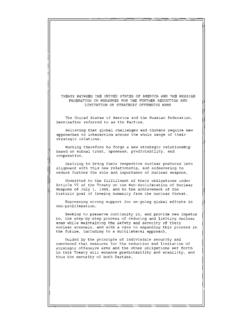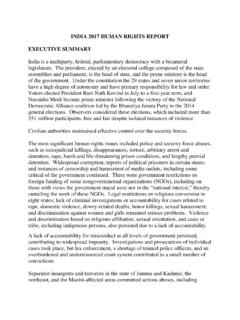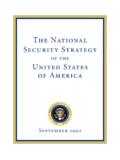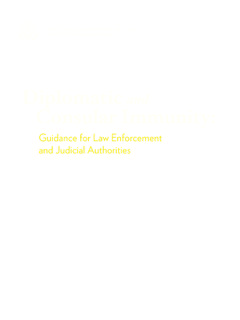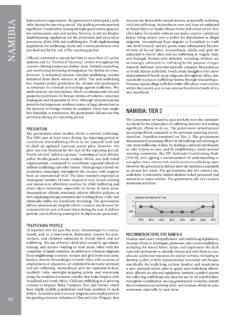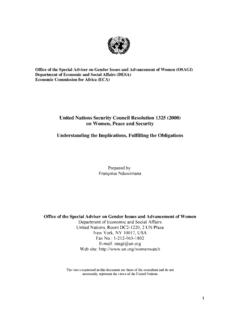Transcription of THE ORDER OF PRECEDENCE OF THE UNITED …
1 1 THE ORDER OF PRECEDENCE OF THE UNITED states OF AMERICA Revised on November 3, 2017 The UNITED states ORDER of PRECEDENCE is an advisory document maintained by the Ceremonials Division of the Office of the Chief of Protocol. For purposes of protocol, the ORDER of PRECEDENCE establishes the ORDER and ranking of the UNITED states leadership for official events at home and abroad. Although this document establishes a general ORDER for the country s highest-level positions, it does not include every positional title across the federal government. Offices of Protocol for the Executive Departments and independent agencies should be consulted for internal rankings regarding positions not listed. In 1908, the Roosevelt Administration created the first ORDER of PRECEDENCE as a means of settling a history of embarrassment, confusion and miscommunication amongst officials invited to events at the White House. As the structure of the federal government has evolved over time this list has adapted and grown.
2 The President of the UNITED states may make adjustments to The Cabinet, giving certain White House positions the status of Cabinet-rank, positions which then follow the heads of the Executive Departments. One of the primary uses of the ORDER of PRECEDENCE is in diplomacy. International rules on PRECEDENCE were first established at the Congress of Vienna in 1815. By determining that envoys of equal title would be ranked according to the date and hour that they presented their credentials to the government that accredited them for service, the Congress of Vienna solidified a fair and justifiable system for diplomatic relations. These same rules are still used to determine the ORDER of PRECEDENCE of the Diplomatic Corps in Washington, Additionally, when on official business in the UNITED states , foreign government officials are afforded the same protocol ranking as their corresponding position in the UNITED states government.
3 A few basic principles regarding PRECEDENCE should be noted. First, the host or hostess of a meeting or event always takes the primary position of PRECEDENCE , regardless of their title or traditional ranking. Second, a person s relative PRECEDENCE may increase or decrease depending on the policy or context behind the particular meeting or event, or based on the wishes of the host on any occasion. The methodology used in ordering officials for this list includes the UNITED states Code; statutory prescription on PRECEDENCE , including Executive Orders; well-established and widely-accepted principles, procedures and traditions throughout the history of the ORDER of PRECEDENCE ; the current structure of the federal government and the Executive Departments; and finally, recommendations by the Chief of Protocol based on practical treatment of a particular position or positions. For any questions regarding the UNITED states ORDER of PRECEDENCE , please email the Office of the Chief of Protocol at 2 UNITED states ORDER OF PRECEDENCE Revised 11/1/17 1 President of the UNITED States1 2 Vice President of the UNITED states 3 Governor of a State (when in own state) 4 Speaker of the House of Representatives 5 Chief Justice of the UNITED states 6 a Former Presidents of the UNITED states or their widows/widowers (by ORDER of their presidency) b Former Vice Presidents of the UNITED states or their widows/widowers (by ORDER of their presidency) 7 a American Ambassadors Extraordinary and Plenipotentiary to foreign governments (when at post) (see 27a) b American Ambassadors, Permanent Representatives or Representatives to international organizations who hold Chief of Mission authority (when at post) (see 27c)
4 2 8 Secretary of State 9 Ambassadors Extraordinary and Plenipotentiary of foreign bilateral diplomatic missions to the UNITED states (in ORDER of presentation of credentials to the President) 10 a Associate Justices of the Supreme Court (ranked by date of appointment) b Retired Chief Justices of the UNITED states (ranked by date of appointment) c Retired Associate Justices of the Supreme Court (unless they resigned) (ranked by date of appointment) 11 The Cabinet (other than the Secretary of State), ranked according to date of establishment of the Department3, and as added by the President*4, as follows: a Secretary of the Treasury b Secretary of Defense c Attorney General d Secretary of the Interior e Secretary of Agriculture f Secretary of Commerce g Secretary of Labor h Secretary of Health and Human Services i Secretary of Housing and Urban Development j Secretary of Transportation k Secretary of Energy l Secretary of Education m Secretary of Veterans Affairs n Secretary of Homeland Security o Chief of Staff to the President* p Administrator, Environmental Protection Agency* q Director, Office of Management and Budget* r UNITED states Trade Representative* s UNITED states Permanent Representative to the UNITED Nations* 3 t Administrator, Small Business Administration* u Director of National Intelligence* v Director, Central Intelligence Agency* 12 a President pro tempore of the Senate b Senate Majority Leader c Senate Minority Leader d Senate Majority Whip e Senate Minority Whip f Senators (by length of service.)
5 If the same, by the state's date of admission into the Union or alphabetically by state) 13 Governors of states - when outside their own states (Relative PRECEDENCE among governors, all of whom are outside their own state, is determined by each state's date of admission into the Union or alphabetically by state) 14 a House Majority Leader b House Minority Leader c House Majority Whip d House Minority Whip e Members of the House of Representatives (by length of service; if the same, by the state s date of admission into the Union or alphabetically by state) 15 a Delegates to the House of Representatives (nonvoting members) from Territory of American Samoa, District of Columbia, Territory of Guam, Commonwealth of Puerto Rico, and UNITED states Virgin Islands (by length of service; if the same, by the territory s date of entering jurisdiction or alphabetically by territory) b Governors of Commonwealth of Puerto Rico, Territory of Guam, Territory of American Samoa, UNITED states Virgin Islands, and the Commonwealth of the Northern Mariana Islands (determined by territory s date of entering jurisdiction or alphabetically by territory) 16 a Assistant to the President and Deputy Chief of Staff (ranked by date of appointment) b Assistant to the President for National Security Affairs (also known as the National Security Advisor ) c Assistant to the President and Senior Advisor (ranked by date of appointment) d Assistant to the President and Chief of Staff to the Spouse of the President e Assistant to the President and Chief of Staff to the Vice President f Assistants to the President (ranked by date of appointment)
6 G Chair, Council of Economic Advisors h Director, Office of National Drug Control Policy i Chair, Council on Environmental Quality j Chief of Protocol (when at the White House or accompanying the President) (see 27b) 17 a American Ambassadors, Permanent Representatives or Representatives to international organizations who do not hold Chief of Mission authority (when at post) (see 27d)5 b Charg d Affaires ad interim assigned to foreign bilateral diplomatic missions to the UNITED states (in ORDER of date of assumption of this position) 18 a Former Secretaries of State (by seniority of assuming office) b Former Cabinet Members (by seniority of assuming office) c Former Senators (by Leadership position, then length of service; if the same, by state s admission into the Union or alphabetically by state) 4 d Former Governors of states (when in own state; ranked by seniority of assuming office) e Former Governors of states (when outside their own states ; relative PRECEDENCE among governors, all of whom are outside their own states , is determined by each state s date of admission into the Union or alphabetically by state) f Former Members of the House of Representatives (by Leadership position, then length of service.)
7 If the same, by state s admission into the Union or alphabetically by state) 19 Deputies to Members of The Cabinet, ranked according to date of establishment of the Department, and as added by the President*6, as follows: a Deputy Secretary of State b Deputy Secretary of the Treasury c Deputy Secretary of Defense d Deputy Attorney General e Deputy Secretary of the Interior f Deputy Secretary of Agriculture g Deputy Secretary of Commerce h Deputy Secretary of Labor i Deputy Secretary of Health and Human Services j Deputy Secretary of Housing and Urban Development k Deputy Secretary of Transportation l Deputy Secretary of Energy m Deputy Secretary of Education n Deputy Secretary of Veterans Affairs o Deputy Secretary of Homeland Security p Deputy Administrator, Environmental Protection Agency (EPA)* q Deputy Director, Office of Management and Budget (OMB)* r Deputy UNITED states Trade Representative (USTR)* s Deputy Permanent Representative of the UNITED states to the UNITED Nations (USUN)* t Deputy Administrator, Small Business Administration (SBA)
8 * u Principal Deputy Director of National Intelligence* v Deputy Director, Central Intelligence Agency (CIA)* 20 a Secretary of the Army b Secretary of the Navy c Secretary of the Air Force d Chairman, Joint Chiefs of Staff 21 a Chairman of the Board of Governors of the Federal Reserve and Commissioner of Social Security of the Social Security Administration b Heads of Federal Independent Agencies at Level II of the Executive Schedule (ranked by agency s creation date; if the same, by length of service).7 These agencies include, but are not limited to, the following (see APPENDIX A): Science Foundation (NSF), National Aeronautics and Space Administration (NASA), Agency for International Development (USAID), Nuclear Regulatory Commission (NRC), Office of Personnel Management (OPM), Millennium Challenge Corporation (MCC) c Vice Chairman and Governors of the Federal Reserve System (by length of service) d Deputy Commissioner, Social Security Administration e Deputy Director, Office of National Drug Control Policy (ONDCP) f Director of the National Counterterrorism Center (NCTC) 22 a Under Secretaries of State and Counselor of the Department (as ranked by State Department) b Under Secretaries of Executive Departments, Treasurer of the UNITED states , Associate Attorney 5 General and Solicitor General (according to date of establishment of the Department.)
9 If more than one from a Department, then as ranked within the Department) c Heads of Federal Departmental Agencies that report to the head of an Executive Department, including, but not limited to the following agencies: Defense Agencies, Federal Bureau of Investigation, Secret Service, Federal Aviation Administration, and Customs & Border Protection. (ranked by date of establishment of the Department; if more than one from a Department, then as ranked within the Department) 23a Retired Chairman, Joint Chiefs of Staff8 b Vice Chairman, Joint Chiefs of Staff c Chief of Staff, Army; Commandant of the Marine Corps; Chief of Naval Operations; and Chief of Staff, Air Force ( ORDER is established by date of appointment) d Chief, National Guard Bureau e Commandant of the Coast Guard f Combatant Commanders ( ORDER is established by date of appointment)9 24 a Heads of Federal Independent Agencies at Level III of the Executive Schedule (ranked by agency s creation date.
10 When the same, by length of service) These agencies include, but are not limited to, the following (see Appendix A): International Trade Commission (USITC), Export-Import Bank of the UNITED states , Federal Communications Commission (FCC), General Services Administration (GSA), Peace Corps (PC), Trade and Development Agency (USTDA), National Foundation on the Arts and Humanities (NFAH), National Archives and Records Administration (NARA), Overseas Private Investment Corporation (OPIC), Merit Systems Protection Board (MSPB) b Deputy Heads of Federal Independent Agencies at Level III of the Executive Schedule (ranked by agency s creation date, when the same, by length of service). See Appendix A. c Postmaster General 25 Lieutenant Governors (when in own State) 26 Mayors of cities and the District of Columbia when in own city10 27 a American Ambassadors Extraordinary and Plenipotentiary to foreign governments (on official business in the UNITED states or another country) (see 7a) b Chief of Protocol (when at the Department of State or at events outside the White House) (see 16k) c American Ambassadors, Permanent Representatives or Representatives to international organizations who hold Chief of Mission authority (on official business in the UNITED states or when representing the UNITED states at a meeting of their international organization away from post) (see 7b) (see Endnote 2 for list of positions) d American Ambassadors, Permanent Representatives or Representatives to international organizations who do not hold Chief of Mission authority (see 5c for list)
